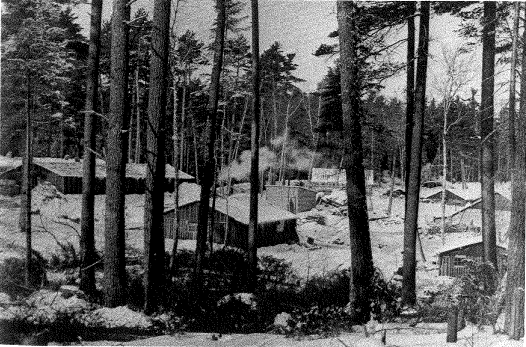|
Winter marked the start of the work season for lumberjacks. Cold temperatures meant the sap in the trees would be frozen, making it significantly easier to saw through them. Lumber camps in the northern woods of Minnesota, Wisconsin, and Michigan sprang to life in the fall as the log sheds, called "shanties" that the workers lived in were erected. The shanties were located as close to the pine trees as possible, to minimize the amount needed to travel in the harsh Midwestern winters. A fire located in the center of the shanties were burn continuously through the season to keep the cold at bay. Temperatures could easily reach -20° F, so staying warm and dry was highly important. Clothes and shoes would be hung up in the rafters of the shanties to dry overnight while the men slept. These workers would work from dawn until the sun set everyday but Sunday. Sunday was wash day and the men would launder their clothes, get their hair cut, and mend any clothes that had been torn. While it was their one day of rest, there was always work to be done around the camp. Food was eaten in the mess hall silently, as talking would distract the cooks and men from getting back to work. Typical meals consisted of pork, bread, beans, and molasses. Many camps kept their own pigs to have a supply of pork ready. Logging camps also had their own blacksmith and stores for workers to purchase daily needs. Horses were necessary for pulling the fallen logs back to camps and so having a blacksmith on site to shoes the horses was a necessity. To keep the sleighs moving, hay and dirt were dumped on gouges in the ice to help the horses and sleigh with traction. The saws used by the workers would need to be constantly refiled to stay sharp so one man was designated as the "filer". Personal items such as clothes, socks, tobacco, and knives were sold on site as well. Having all of the necessities taken care of at the camps made for more productive work as workers did not have to leave camp and travel. Come April when the ice on the rivers would thaw, the logs would be taken and placed on rafts to floated down the river. This marked the end of the work season for the lumberjacks. Some would return to towns that had sprung up around the logging camps and wait for the next season; others would travel elsewhere looking for more work. While the work was hard and in harsh conditions, it was necessary as people began to move further and further west and the demand for building materials rose.
Comments are closed.
|
ArchivesCategories
All
|


 RSS Feed
RSS Feed